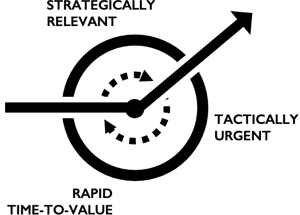This is why (some) B2B customers are still buying in the current climate...
May 13, 2020

 There’s no doubt that the vast majority - if not all - of discretionary, could-put-it-off until later B2B purchases are being deferred in the current climate.
There’s no doubt that the vast majority - if not all - of discretionary, could-put-it-off until later B2B purchases are being deferred in the current climate.
If your prospects don’t feel they have to take action, they won’t, and no amount of bluster or misguided sales heroics will change that.
Risk mitigation is the primary driver, and if they believe that the costs, risks and consequences of simply sticking with the status quo are manageable or insignificant, that’s exactly what they will do, and they will hold onto their cash until the upturn comes. And who could blame them?
But despite all of this, B2B customers are still making discretionary purchases. Some (the ultimate cash conservers) are in total investment lockdown mode. But others see opportunity and are investing to make themselves stronger in both the short and the long term.
But their investment parameters have changed...
Basically, they are still prepared to invest when and where the issue they are trying to address is:
- Strategically relevant
- Tactically urgent and
- The solution promises rapid time-to-value
Taken together, these three factors combine to create a “sweet spot” where customers are prepared to buy, and where salespeople can win their business. Let’s briefly examine each of these in turn.
Strategically relevant
Whilst being strategically vital would be nice, it’s not always necessary. Simply being strategically relevant can often be sufficient. This means that the project you are involved in is seen to be supportive of one or a number of the customer’s key current strategic priorities or initiatives.
Tactically urgent
But being strategically relevant isn’t enough. The project you are involved in also needs to be seen as tactically urgent. This means that the change the customer is trying to achieve needs to happen quickly. With this in mind, it’s also worth bearing in mind the research by Kahneman and others that showed that individuals and organisations were more likely to change their behaviour in order to avoid a current risk or threat rather than in the hope of achieving a future gain.
Rapid time-to-value
The third factor contributing to this sweet spot is time-to-value. Large investments that have the potential for large paybacks - but over an extended period of time - are far less likely to be approved quickly than smaller investments that are likely to generate short-term paybacks. This means that a “land, succeed and expand” strategy is far more likely to get traction than trying to sell a multi-year transformation project.
This, in turn, means that we need to identify our customer’s “minimum viable problem” - something that is important enough to drive action, yet straightforward enough to allow a relatively rapid and uncomplicated decision and approval process.
Selling what customers are buying
In conclusion, sales organisations need to identify and target the key business issues their ideal customers are prioritising. They need to uncover their customer’s minimum viable problems and resist the temptation to make the initial project any larger than absolutely necessary.
They need to eliminate any reservations the customer might have about accepting their proposal. They need to understand the outcomes the customer is expecting the project to achieve. They need to achieve those outcomes as quickly and as unambiguously as they can.
And then they will have earned the right to expand their current footprint, to identify new opportunities and to build a progressively strategic relationship with the customer. But it all starts with finding and closing a project that is strategically relevant, tactically urgent and gives them the change to demonstrate rapid time-to-value.
But (and this probably ought to go without saying, but here goes) succeeding in this strategy will inevitably require that the salesperson concerned demonstrates abundant emotional intelligence, empathy and business acumen - and it has to be based on exceptional discovery and diagnosis skills.
If any of this resonates with you - and if in particular you agree with me that salespeople needs to stop promoting generic ‘solutions’ and start achieving customer-specific outcomes, I hope that you’ll enjoy our latest guide to the subject, which you can download here...
A version of this article was first published on the LinkedIn.
ABOUT THE AUTHOR
 Bob Apollo is a Fellow of the Association of Professional Sales, a founding contributor to the International Journal of Sales Transformation, an active member of the Sales Experts Channel and the Sales Enablement Society, and the driving force behind Inflexion-Point Strategy Partners, the leading proponents of outcome-centric selling.
Bob Apollo is a Fellow of the Association of Professional Sales, a founding contributor to the International Journal of Sales Transformation, an active member of the Sales Experts Channel and the Sales Enablement Society, and the driving force behind Inflexion-Point Strategy Partners, the leading proponents of outcome-centric selling.
Following a successful corporate career spanning start-ups, scale-ups and market leaders, Bob now works as a strategic advisor, mentor, trainer and coach to ambitious B2B sales organisations - teaching them how to differentiate themselves through their provably superior approach to achieving their customer's desired outcomes.


Comments